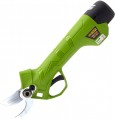Max. cutting diameter
The largest diameter (thickness) of a branch that the tool can handle.
The larger the maximum cut diameter, the more powerful this model, the lower the likelihood that a certain branch will be too tough for the tool. At the same time, note that to ensure high power, long handles and strong blades are needed, which accordingly affects the dimensions, weight and price. Therefore, it is worth choosing according to this parameter with a certain margin, but at the same time, this margin should not be too large.
As for specific figures, a maximum diameter
of 20 mm or less is considered relatively small, but it often turns out to be quite enough for simple work.
21 – 30 mm — the average value,
31 – 40 mm — above average, and in loppers the maximum thickness can
exceed 40 mm.
Battery in set
Modern cordless pruning shears can be supplied
with or
without a battery ; Moreover, in the first case, a different number of batteries may be provided (1 pc or 2 pcs), or even
a built-in power source. It is also worth noting that models with a removable battery usually do not use any original batteries, but universal solutions for power tools from the same manufacturer. The advantage of this design is obvious: first of all, it facilitates the search for power sources, including in addition to or as a replacement for “original” batteries. Here is a more detailed description of specific configuration options:
- 1 PC. Devices supplied with just one replaceable battery. This package may seem almost ideal: the tool can be used immediately after purchase, and when purchasing you do not have to overpay for a second power source. This configuration is designed mainly for two situations. The first is when the tool is planned to be used for short-term work, i.e. it is possible to take significant breaks to charge the battery; the second - if the household already has at least one spare battery, so there is no point in buying a model with 2 batteries.
- 2 pcs. The presence of a second battery inevitably affects the cost, but in many cases this point is more than offset by the additional ease of use. Firstly, two batteries allow you to work longer without interru
...ptions - in fact, autonomy is doubled. Secondly, while one battery is in use, the second one can be kept on charge; This allows you to minimize charging breaks, or even get rid of them altogether. Thirdly, the breakdown or loss of one power source does not interfere with work - it is enough to install a second one. And fourth, the spare battery may be useful for another compatible power tool.
- Without battery. The most popular option in principle is battery powered. Along with the obvious inconvenience - the tool cannot be used out of the box - this package has a number of significant advantages. First of all, the customer can choose the model and number of batteries at his own discretion, without relying on the manufacturer in this matter. And if there is another battery-powered tool on the farm, then the power source from it may well be suitable for pruning shears; This will completely eliminate the need to spend additional money and time.
- Built-in. The built-in power supply allows you to make such a tool as compact as possible. In addition, the customer does not need to bother with a separate charger - just connect the included cable to charge. On the other hand, a dead battery cannot be quickly replaced with a fresh one - the only option is charging, which requires an energy source and can take a lot of time. Also, this design does not allow you to select batteries at your discretion; and if there are problems with the power supply, you will either have to take the entire device for repairs or replace it with a new one. In light of all this, models with a built-in battery are usually intended mainly for minor home repairs and simple tasks that do not involve long-term work and high loads.Battery voltage
The operating voltage of the battery installed in the tool of the corresponding type (see above).
The higher the power, the higher the voltage may be required (but not necessarily required) to power it efficiently. In other words, a high battery voltage is usually indicative of advanced performance, while a low battery voltage is not always a sign of an entry-level tool. On the practical side, this parameter can only be useful for some specific tasks — for example, looking for an external charger for a battery or buying a spare battery. In addition, this parameter must be taken into account when comparing different batteries in terms of capacity (for more details, see "Battery Capacity").
Battery capacity
The capacity of the battery supplied with the tool.
Theoretically, the higher the capacity, the more energy the battery accumulates and the longer the tool is able to work on a single charge. In fact, however, two points must be taken into account. Firstly, only batteries with the same voltage can be directly compared in terms of capacity in ampere-hours (if there is a difference in voltage, you need to convert the capacity to watt-hours using a special formula, and use these values already). Secondly, the actual battery life will depend not only on the characteristics of the battery, but also on the power consumption of the device itself; at the same time, the power consumption for battery models is not directly indicated in the characteristics.

